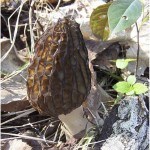Certain types of mushroom-looking fungi reproduce by shooting thousands of spores out into the air all at once. If they are lucky, the spores find an air current to ride far away to a new habitat, to start lives of their own. It seems like a pretty straightforward game of chance for the spores, but as is usually the case in nature, there is more to the story than meets the eye.

Morel, a type of apothecial fungus
Different types of fungi feature a variety of adaptations to maximize the survival rate of their spores. For apothecial fungi, a type that ejects spores en masse, maximum spore survival is a story of sacrificing some for the benefit of the majority. In a recently published article in PNASProceedings of the National Academy of Sciences, a team of biologists and mathematicians found that the sychronized ejection of thousands of spores creates a miniature “wind” that carries many of the spores much further than they could travel alone.
In general, a spore’s chances for survival increase with the distance it travels away from the parent fungus. A spore doesn’t want to land back on top of the fungus, or right next to it, because there’s usually not enough food around to share. Picture a fungus growing out of the ground, in a shady area surrounded by shrubs. An ejected spore needs to travel far enough away from the still air surrounding the fungus to find natural air currents out in the open to waft it away. Furthermore, when it shoots out of the fungus, it needs to avoid hitting obstacles like leaves. The apothecial fungi’s approach of releasing all of its spores at once seems to provide some advantage, and the researchers wanted to figure out what this was.
They approached this study in two ways: (1) using a high-speed camera to film fungi releasing spores, and (2) performing mathematical simulations of thousands of particles (representing spores), taking into account things like wind resistance and deceleration due to gravity.
The apothecial fungi contain thousands or millions of little sacs called asci, each containing several spores. When a small group of asci are triggered to release spores (by a gust of wind, by being bumped, or even just spontaneously), the nearby asci are almost immediately triggered to release spores due to the change in tension of their neighboring asci. The signal to release spores then continues to travel like a wave across the whole fungus to all the asci. All of this signaling happens so quickly that, to the human eye, it looks like all of the spores release at exactly the same time. However, with a high-speed camera, the researchers were able to observe the progression of spore release across the entire fungus. They then combined what they saw on camera with what they were able to simulate mathematically.
Mathematical spore simulation showed that the force with which the fungus launches a spore is only enough to shoot it about 3 millimeters above the fungus surface. However, the earliest spores to be ejected mobilize the surrounding air, causing a little air current. As more asci are triggered to launch spores, the air current blowing away from the fungus accelerates. The later spores released into the air current established by earlier spores are carried well beyond the distance they would otherwise be limited to. In fact, the spores that are assisted by this little current can travel as much as 20 times as far as lone spores released individually. Additionally, the little air pressure gradients within the jet of released spores help the spores to circumnavigate obstacles like leaves.
The catch here is that the earliest spores to be released help to create the air current, but don’t get to ride it, and fall back down near the parent fungus. As individuals, these spores lose, but their sacrifice is critical for the survival of many more.

